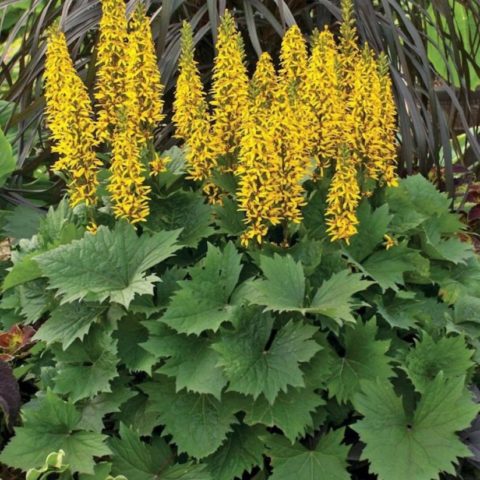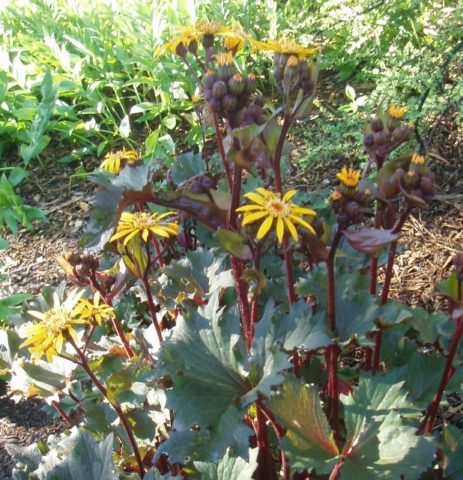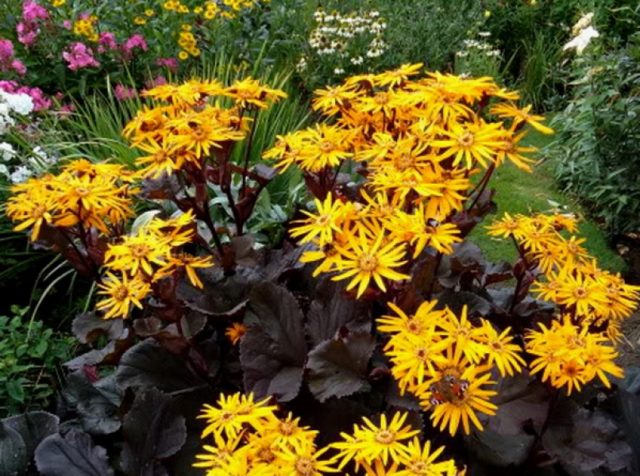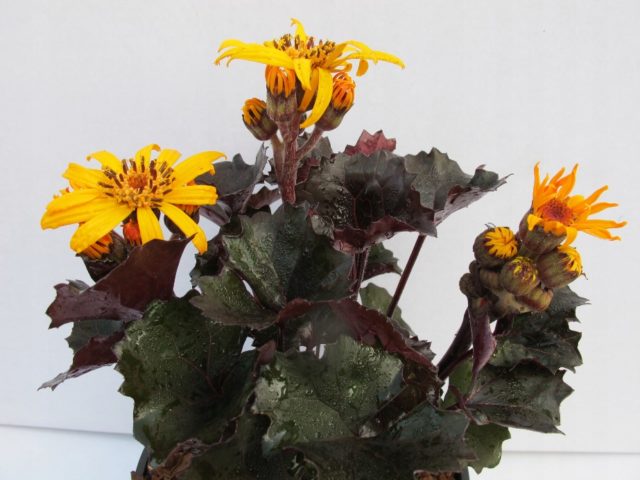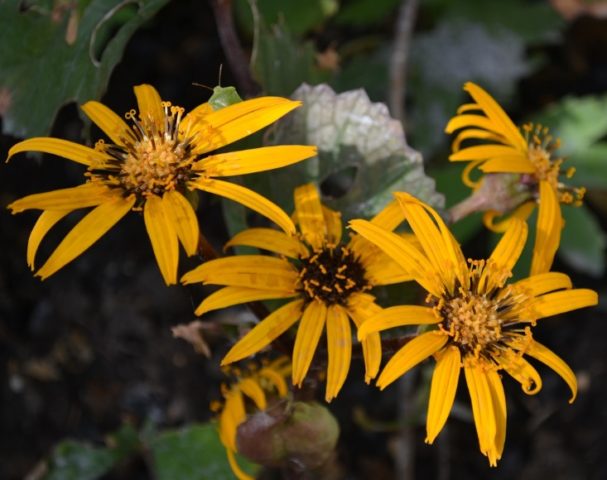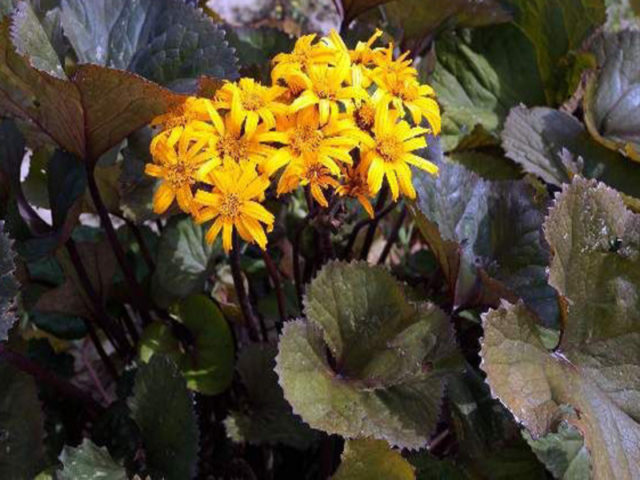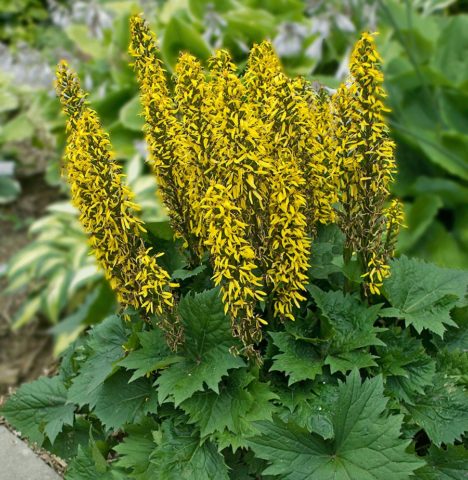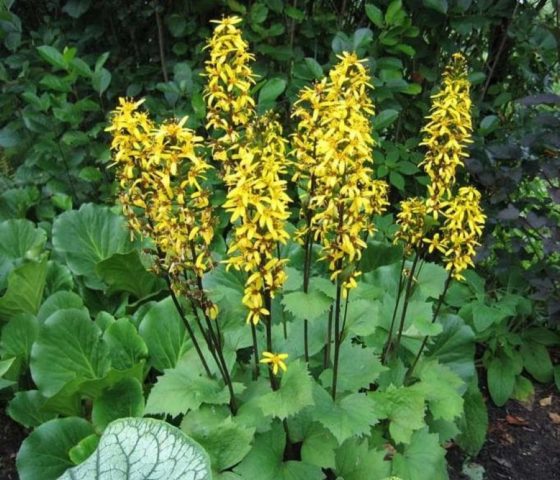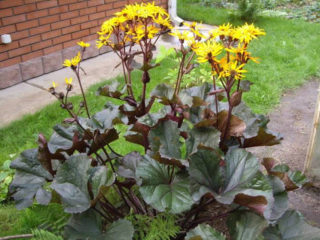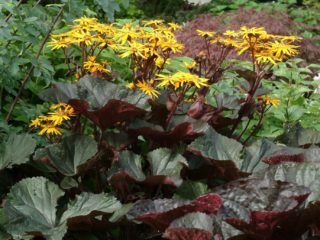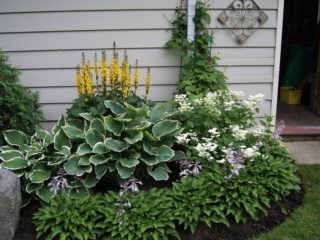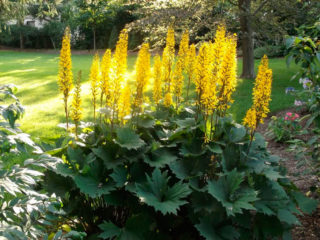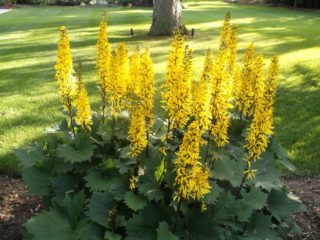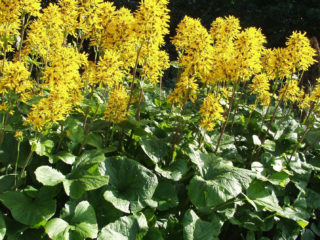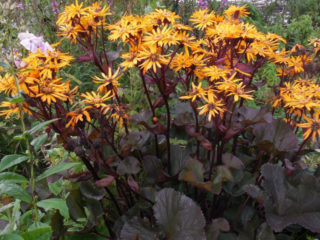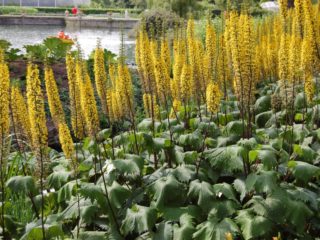Content
- 1 What kind of plant is this - buzulnik
- 2 Types and varieties of buzulnik with photos
- 2.1 Buzulnik Przhevalsky
- 2.2 Wilson's Buzulnik
- 2.3 Buzulnik toothed
- 2.4 Fischer's Buzulnik
- 2.5 Kaempfer's Buzulnik
- 2.6 Buzulnik Vorobyova
- 2.7 Buzulnik largeleaf
- 2.8 Buzulnik palmate lobe
- 2.9 Buzulnik Hessey
- 2.10 Buzulnik narrow-headed
- 2.11 Buzulnik Siberian
- 2.12 Buzulnik Vicha
- 2.13 Buzulnik angustifolia
- 2.14 Buzulnik Tangut
- 3 Planting and caring for buzulnik in open ground
- 4 Pests and diseases
- 5 Conclusion
Various varieties and types of buzulnik with photos and names, presented in their diversity in gardening centers, force one to study information about the culture. The plant has gained popularity due to its appearance and characteristics. A large number of varieties allows you to choose the best option for your site.
What kind of plant is this - buzulnik
The synonymous name for buzulnik is ligularia. The plant is a perennial and belongs to the Asteraceae family. In total, the genus includes more than 150 species of flowers.
In nature, the culture grows freely in Europe and Asia. Thanks to the color of the flowers and shade tolerance, it has become popular among gardeners and landscape designers.
The height of the flower can reach 1.2 m.The stems of the bush are erect. Attached to them are massive, up to 60 cm in diameter, leaf plates in the shape of a triangle or heart. The color of the leaves is varied: from green to greenish-violet. Depending on the species, the plate itself may be green, and the petioles and veins may be purple. There are varieties with two-color leaves, each side of the leaf blade has its own color.
The inflorescences are in the form of baskets, reach 10 cm in diameter, and consist of small flowers painted in bright shades. There are varieties with rich yellow, orange or red buds.
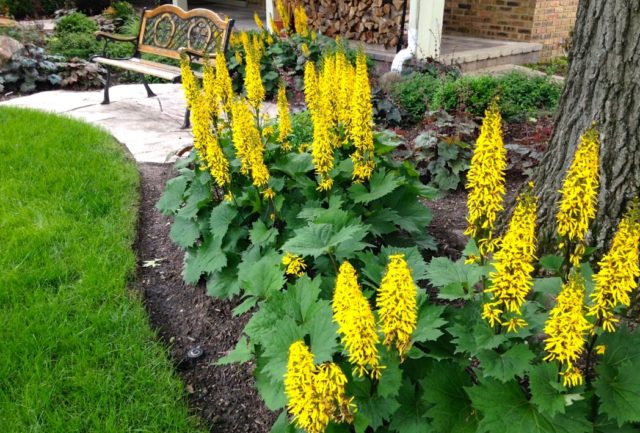
The height of the peduncle varies from 1.5 to 2 m
Types and varieties of buzulnik with photos
There are several varieties and types of plants. They differ in the color of the buds or leaves, and the duration of flowering. Of the 150 names of flowers, about 20 species have been cultivated.
Buzulnik Przhevalsky
Leaves of various shades of green, heart-shaped or bud-shaped, arise from a basal rosette. The width of each leaf blade reaches 60 cm. There are varieties with serrated or palmately divided leaves. Peduncles reach a height of 2 m. The buds are baskets with a diameter of up to 10 cm, collected in inflorescences.
Varieties of Przhevalsky buzulnik:
- The Rocket): a tall variety, reaching 2 m in height, characterized by large serrated leaves that are initially dark green in color, but turn crimson or purple in autumn.
The buds of the buzulnik Rocket are light yellow in color, appear in August, fade in September
- maple leaf, got its name due to the shape of its leaves, similar to maple leaves.
The height of the bush can reach 1.7 m, the diameter of the leaf blades is up to 25 cm, and the yellow inflorescences bloom throughout the season from bottom to top.
In nature, Przewalski's ligularia is common in Eurasia. For the purpose of decorating the garden, it is planted in China and eastern Asia. The plant prefers bodies of water, so it is placed on the banks of ponds or along streams.
Wilson's Buzulnik
In the photo, the flowers of Wilson's buzulnik may seem inconspicuous, but the plant is decorative thanks to its shoots. The height of the bush reaches 1.5 m. The leaf plates are basal, kidney-shaped, and large in size. The inflorescences of Ligularia Wilsoniana are erect, collected from very small yellow baskets. Buds form in July.
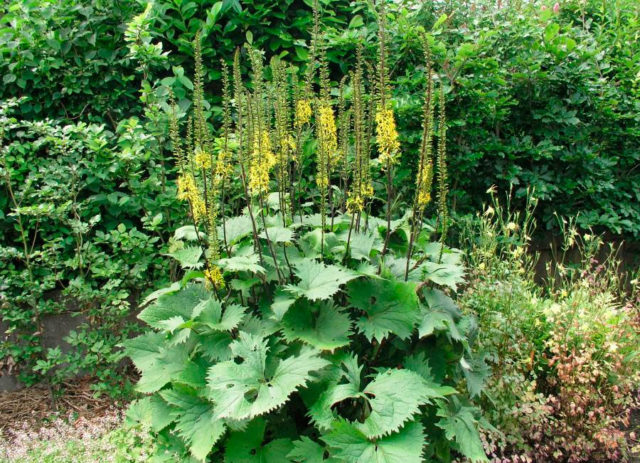
Wilson's buzulnik is not afraid of low temperatures, but in winter it is necessary to provide shelter for it
Buzulnik toothed
Perennial up to 100 cm high, with large leaf blades. Baskets with buds reach 8 cm in diameter, collected in panicle-shaped inflorescences. The Ligularia Dentata species is frost-resistant, but needs shelter in winter.
Varieties:
- Among the longest flowering varieties is the hybrid buzulnik Osiris fantaisie (Osiris Fantaisie), the buds of which form in July and wither only with the onset of frost. The variety is dwarf, the height of the bush is no more than 0.5 m.
The plant is unpretentious, but loves damp places; in the shade it quickly loses its decorative appearance.
- According to photos and reviews, the variety has beautiful inflorescences buzulnik Midnight Lady (Midnight Lady). The height of the crop is 70-80 cm, the leaf blades are round, purple-black in color. Flowers appear in July and are golden daisies.
The variety is moisture-loving and does not tolerate heat and drought well, so it is used in the design of ponds and mixborders.
- Buzulnik Pandora (Pandora) is very compact, the height of the plant is no more than 30 cm, the diameter of the bush reaches 40 cm. The leaf plates are glossy, round in shape, rich purple on one side and green on the other side. The flowers are chamomile-shaped, orange-yellow.
The Pandora variety prefers semi-shaded or well-lit areas with fertile, moist soil.
- Buzulnik Marie Crawford (Marie Crawford) reaches a height of 70-100 cm during the flowering period. The buds of the crop are formed in July and fall off in October. From the photo you can appreciate the beauty of the Marie Crawford buzulnik leaves, they are glossy, one side is dark brown and the other is purple.
The diameter of the Marie Crawford bush spreads up to 100 cm
- Buzulnik Dark beauty (Dark Beauty) reaches a height of 90-120 cm. The leaves are heart-shaped, rich purple in color. The inflorescences are bright orange daisies.
Buzulnik prefers partial shade, but can grow in open areas if proper care is provided.
Often, jagged buzulnik is planted as a tapeworm, giving it shady and damp places on the site. The plant looks beautiful against the backdrop of artificial fountains, ponds, and in the shade of trees.
Fischer's Buzulnik
The height of the shoots is from 700 cm to 900 cm, the leaf blades are dissected and pinnate. Inflorescences in the form of elongated panicles are collected from small yellow flowers.
It has a tuberous root that forms stolons. This feature allows the Fischeri species to be propagated by dividing the rhizome.
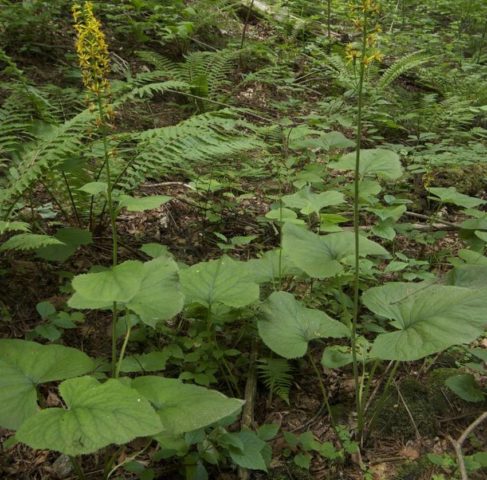
Fisher's buzulnik blooms in July and August
Kaempfer's Buzulnik
The culture is also called Japanese buzulnik. Its shoots are slightly branched, the leaves are basal, bud-shaped, with light pubescence on the petioles.They can reach 25 cm in diameter.
During the flowering period, baskets of pale yellow buds with a diameter of up to 5 cm are formed on the Kampfer bush. They are collected in corymbose inflorescences, which appear in July.
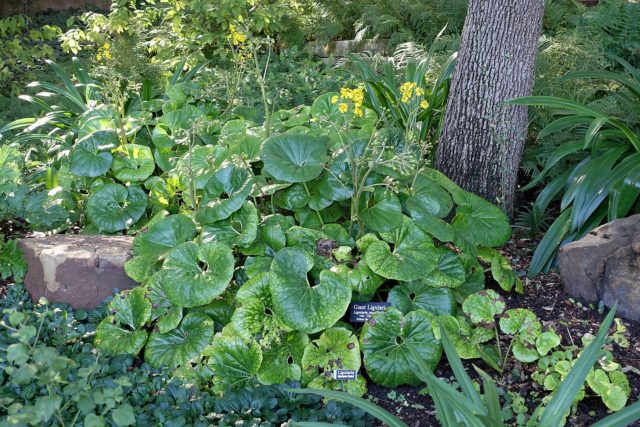
There is an early flowering variety of Japanese buzulnik, its flowers are golden in color.
Buzulnik Vorobyova
The perennial stretches up to 2 m in height, forms during the growth process into a large shrub with leathery, thickened foliage, round in shape and dark green in color.
The flowers are voluminous, collected in clusters, appear in early August. Ripe seeds are small in size and sensitive to sunlight.

The Vorobyov variety is recommended for use when creating autumn gardens due to the long flowering period and rich colors
Buzulnik largeleaf
Among all the varieties and types of buzulnik, Ligularia macrophylla has a different shape of leaf plates. They are elliptical in shape, on long petioles, and have a green with a grayish tint. The length of each leaf plate is 35-45 cm.
Flowering begins in July and ends in September. The inflorescences are in the form of a brush, formed from baskets with yellow buds. The height of shoots with panicles reaches 1.5 m.
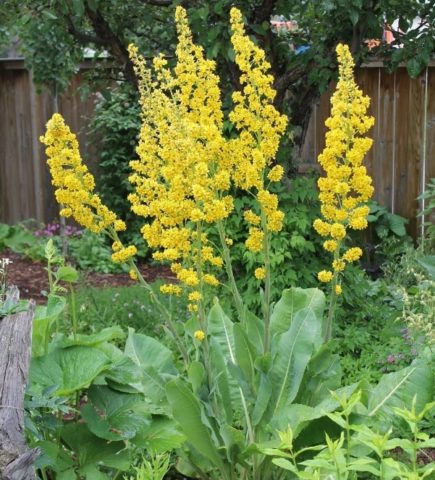
The species is frost-resistant, does not require shelter, and is used to create flower beds
Buzulnik palmate lobe
The height of the ligularia is up to 1.8 m, the diameter of the bush grows up to 0.9 m. The lower leaves of the buzulnik are large, round in shape, and lobed.
The flowers are yellowish in color, collected in loose clusters. Buds form in July-August.
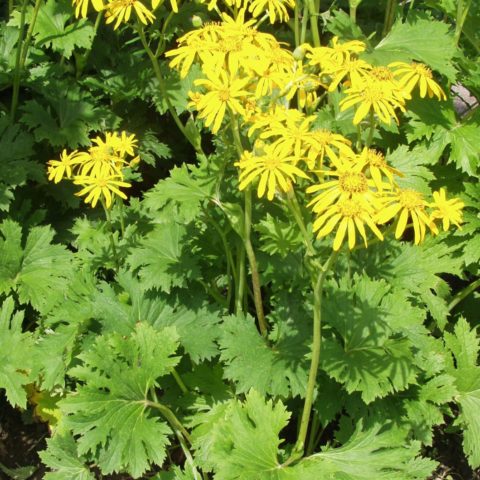
The crop is demanding on soil moisture and does not tolerate extreme heat.
Buzulnik Hessey
The hybrid was obtained by crossing buzulnik serrated and Wilson.Externally, the plant is similar to Ligularia serrata, but the inflorescences are less dense. The diameter of the baskets does not exceed 5 cm. The shape of the flowers is similar to daisies. The leaves are triangular-heart-shaped.
The height of the Hessei species is up to 2 m, in diameter up to 1 m.
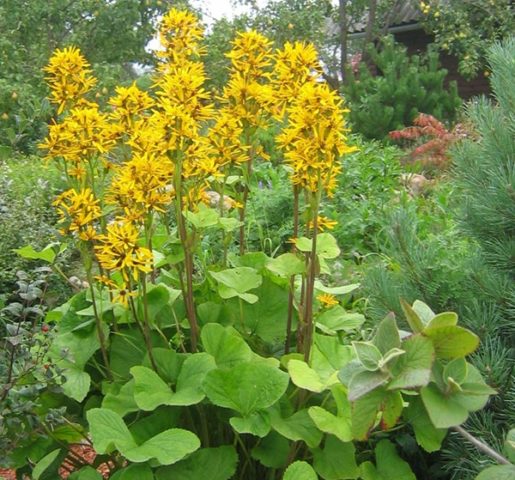
The flowering period of the species is August-September
Buzulnik narrow-headed
The herbaceous perennial has strong, red-brown shoots. The leaf blades are a rich green hue, triangular in shape with teeth. The buds are small, united in baskets, collected in paniculate inflorescences. The flowering of narrow-headed buzulnik begins in August.
Varieties:
- Bottle Rocket (Bottle Rocket) is 80 cm high, has dark green leaf blades and yellow inflorescences located on dark petioles.
The compactness of the shrub allows it to be used effectively in mixborders and flower beds, near trees and other large plantings in the foreground
- Gold Torch (Gold Torch), bush height 1 m, leaf blades are initially beet-colored, but gradually become greenish-bronze with a purple underside. The buds are a rich yellow hue, attached to purple peduncles.
The variety looks good both in single plantings and in group compositions; it prefers proximity to mantle or miscanthus
The species is frost-resistant, but in severe winters it requires shelter.
Buzulnik Siberian
The Siberian perennial, depending on conditions, grows from 0.3 to 1.3 m. The shoots are grooved, the leaves come in various shapes: heart-shaped, triangular or round. The inflorescences are racemose and consist of yellow baskets.
Widespread in Europe and Siberia, prefers marshy meadows and lowlands.
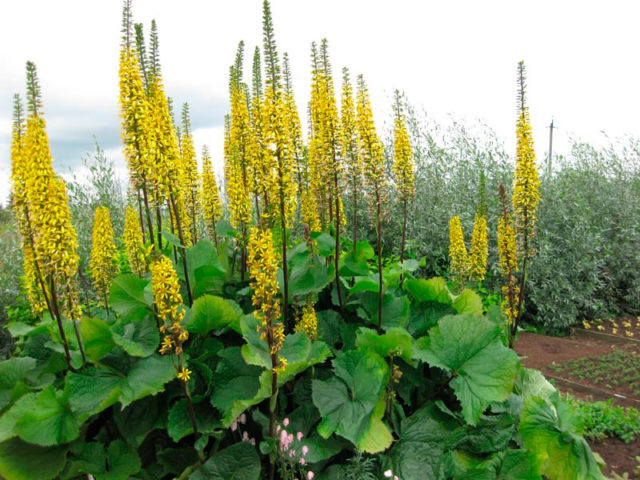
Siberian ligularia is included in the Red Book of the Tver region
Buzulnik Vicha
The homeland of the perennial Vicha is China. The height of ligularia is up to 2 m, the stem is thin but strong. Spike-shaped inflorescences of disk-shaped, yellow flowers are attached to it. The leaf blades are heart-shaped, elastic, with teeth along the edges.
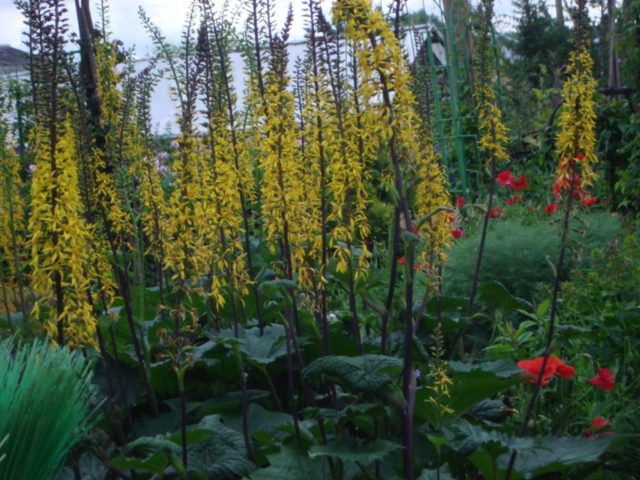
The buds appear in August and fade at the end of September.
Buzulnik angustifolia
The angustifolia perennial has an external resemblance to Przewalski's ligularia. But its flowers are larger, up to 5 cm in diameter, and its leaves are sharp, slightly serrated.
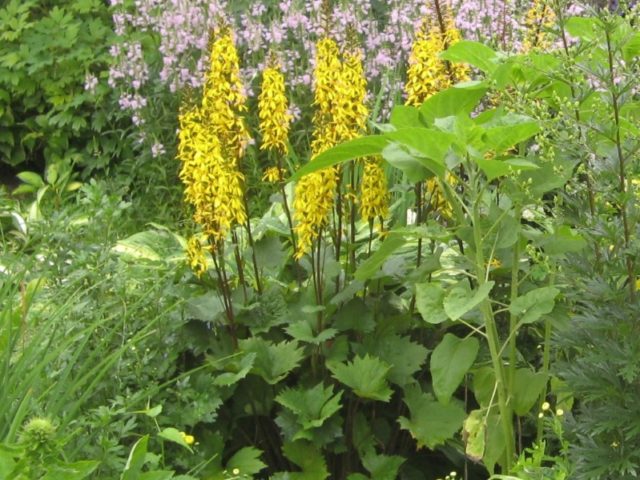
Buds appear in August and fade in September
Buzulnik Tangut
The Tangut species has sparse shoots, up to 1 m high. The inflorescences are slightly elongated, consisting of small yellow buds. The leaf blades are dissected and openwork.
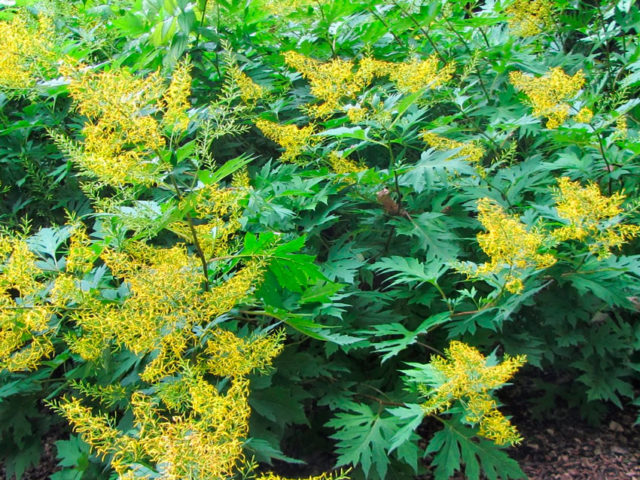
The variety is very decorative: the leaf blades are compared to the wings of a butterfly, the inflorescences are preserved on the shoots from July to October
Planting and caring for buzulnik in open ground
It is necessary to allocate a shaded place on the site for ligularia. In open areas the bush will grow, but will quickly fade.
The soil for a perennial should be fertile, loose and well-retaining water.
Since most varieties of perennials are tall, the planting site should be protected from the wind.
Deadlines
The recommended time for planting is spring. Before sowing seeds, you should take into account the characteristics of the region: in most areas, the optimal month for all procedures is May.
Soil preparation
If the soil is not fertile, then garden soil and humus must be added to the garden bed.It is recommended to use superphosphate and wood ash as fertilizer.
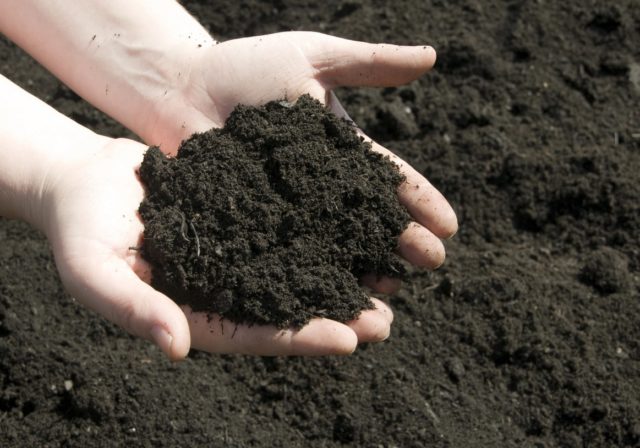
Chernozem should be soft, crumbly; for better moisture retention, it can be mixed with sand
Landing algorithm
The shape of the bed can be arbitrary, but it should be taken into account that the plant tends to grow; most varieties reach 1 m in diameter.
Landing algorithm:
- The procedure is carried out in the morning or evening. The soil is moistened abundantly.
- Plant the seeds to a depth of 1 cm and sprinkle with soil.
- In regions with short summers, it is recommended to sow buzulnik seedlings in January-March and transplant young plants into open ground in May.
Flowering occurs 4-5 years after the introduction of seed.
If you need to plant a seedling, then add mineral fertilizers to the planting hole, place the plant there, and bury the root. Water the perennial abundantly and mulch the soil around it.
Watering and fertilizing schedule
A perennial cannot do without moisture. During periods of drought, watering should be done daily. It is recommended to periodically irrigate the foliage of the plant in the evening hours.
In the autumn months, after flowering has ended, watering will have to be reduced to prevent the roots from rotting.
In the first year after planting, buzulnik does not need fertilizers: it only needs the nutrients added to the bed during planting. In the following years, half a bucket of humus must be added to each bush from May to July.
Weeding and loosening
All weeds must be removed regularly. Loosening should be done after each watering.As an alternative, you can mulch the soil with available materials.
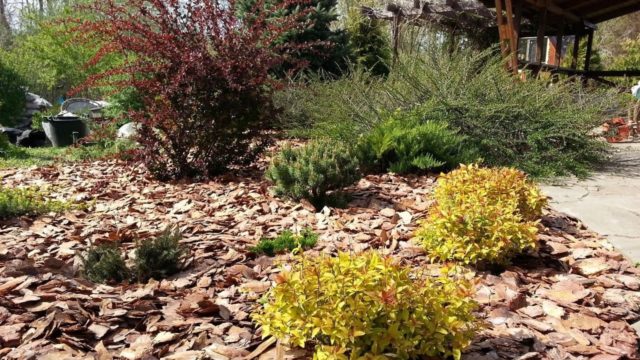
To make the flower garden decorative, you can use leaves, pebbles, colored wood shavings, and chopped grass as mulch.
Installation of supports
If the variety is tall, then during the flowering period wooden or metal spears should be installed next to the shoots in order to tie branches with inflorescences to them.
Most gardeners neglect this procedure, but shoots can break off not only due to gusts of wind, but also under their own weight.
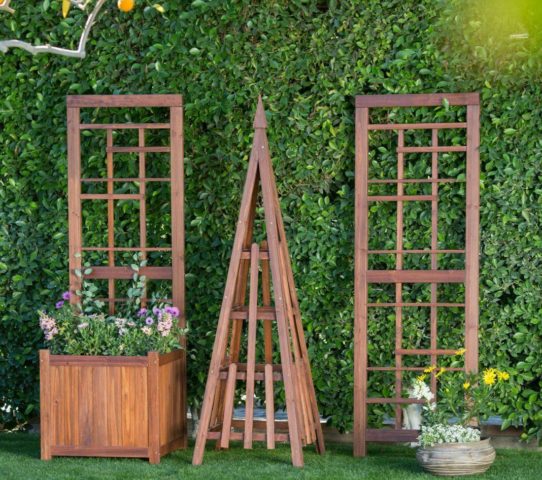
In order not to disturb the decorative effect of the composition, you can use special garden supports when gartering
Trimming
The procedure is carried out in the fall, as soon as the last flower fades. If you plan to propagate the variety by seed, then leave a few panicles.
Flowers are pruned in October. The procedure will allow the plant to redirect its energy to maintaining the rhizomes and leaves, which will help the ligularia survive during the winter months.
Wintering
Preparations for the winter months should begin after the onset of frost. To do this, you need to remove the above-ground part of the plant, mulch the soil around it, and later cover it with snow or special material, leaves.
Pests and diseases
Buzulnik has a strong immune system and is avoided by harmful insects.
In spring, slug attacks are possible. As a preventive measure, granular superphosphate should be scattered under the plant.
With excess moisture and reduced immunity, powdery mildew may appear.
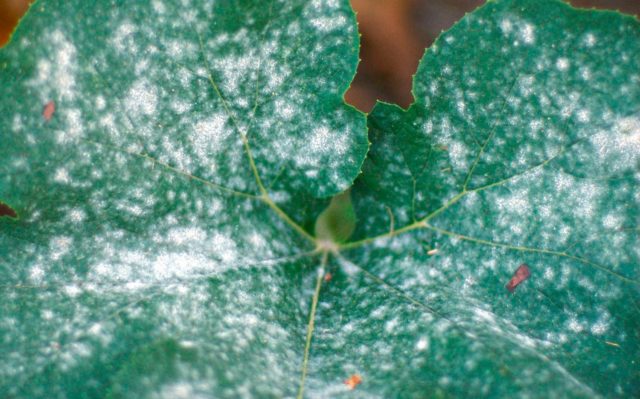
The disease is characterized by the appearance of a white coating on the leaf blades
As a treatment, the bush should be sprayed with a 1% solution of colloidal sulfur.To do this, 2.5 g of the drug must be dissolved in 10 liters of water.
Conclusion
The varieties and types of buzulnik with photos and names are amazing in their diversity, so a gardener can choose a plant according to his preferences. Considering the unpretentiousness of the culture and its love for shady places, ligularia can decorate those corners of the garden where other plants quickly die from lack of light.
